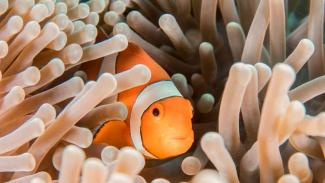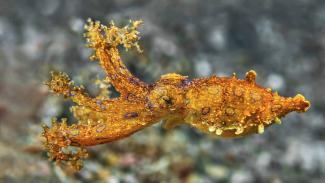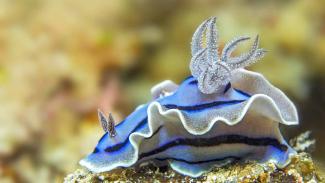
Jakob Owens
Do you struggle to know your arm from your socket, your port from your bracket, your flash from your fisheye and your light from your lens?
Well, you're not alone. Underwater photography has it's own dictionary of parts, accessories & technical terms and it's tough to sound like an expert.
So before you head out and start to talk shop, brush up on your technical knowledge with our interactive guide to underwater cameras and accessories...

The Lowdown
Underwater Housing
The housing is the centrepiece of your underwater photography kit. Usually, each camera or range of cameras has its own underwater housing, allowing you to access all the controls you need underwater. There are a wide range of housings available on the market now, from simple housings made by the camera manufacturer to hi-tech housings costing thousands and lasting a lifetime.
Housings for compact cameras and DSLRs are a little different in design. For comact cameras, the housing is one, fully enclosed unit including a lens port. For DSLR housings, the housing is usually sold without a lens port (think of the lens port as a mini-housing for the camera lens), as a different lens port is needed to accommodate the many different lenses available for DSLR cameras. Some popular brands of underwater housing include Ikelite, Sea&Sea, Nexus, Hugyfot & Patima.
Dome Port
A dome port fits to the front of an DLSR housing, allowing you to use a wide angle lens on the camera. A wide angle lens is a huge bonus in underwater photography as it allows you to get closer to your subject while still fitting it in the frame, which results in a much better image. The dome port you need depends on two factors - the housing you have and the camera lens you want to use.
Macro Port
Just like a dome port, a macro port fits to the front of a DLSR housing and allows you to use a macro lens underwater to get crisp, sharp shots of all those crazy critters. It is possible to get a range of macro lens with differenct levels of magnification.
Mount Base
If you just have a compact camera, it is still possible to attach wide angle and macro lenses to the camera to get better shots. Most compact camera housings require a mount base, which attaches to the lens port on your housing. This not only makes the lens port stronger and able to hold a lens, but also has the correct fitting to keep the lenses in place. If you go for this set-up, then you will also need to buy a 'wet lens' - a lens that attaches to the outside of the housing (and therefore gets wet). Before you buy your wet lens & mount base for your compact camera, it's important to check that they use the same size fitting, otherwise you are wasting your money. Popular brands of wet lens are Inon, Epoque & Ikelite.
Strobe
A strobe acts as your flashlight underwater. They can make a huge difference to the quality of your image and should be at the top of your list of accessories to buy. Strobes do two things that you standard camera flash can't do.
Firstly, they help to get rid of backscatter. Standard camera flashes fire in exactly the same direction as your lens and reflect off particles in the water, creating backscatter. Strobes get round this problem by allowing you to use fire the flash from above or at an angle, meaning less backscatter (and sometimes none at all). Secondly, they can provide a more powerful flash that covers a wider angle, meaning that your photo will be better lit.
For compact cameras, strobes usually copy the cameras standard flash or require you to set the strenngth of the light manually. For DSLR's, they usually connect via the camera's hotshoe and are triggered directly from the camera. Most underwater photographers are happy with one strobe, but more serious photographers may opt for two strobes, which provide both more light and more options. Popular brands of strobe are Inon, Sea&Sea, Epoque & Ikelite.
Arms & Trays
To connect your underwater housing to your strobe, you will need an arm, a tray and sometimes even a handle. These accessories are pretty straight forward and fit together in a way that allows you to position that strobe as you wish, while keeping your hands free to take the picture. Some arms also allow you to attach wet lenses or other accessories to them for handy storage. Most retailers sell strobes together as a package with the arms, trays and handles you will need. If you want to do very wide angle photography, then you may need a longer arm, which will allow you to position the strobe further away from the camera and light a wider area. Likewise, if you want to do macro photography, a shorter arm may prove more useful.
O-rings & O-ring Grease
Underwater housings have many parts that are moveable, or that open completely. These areas need to be sealed so that water does not enter. This is done with rubber o-rings - a small, circular piece of rubber that creates an effective seal. O-rings come in many sizes and any underwater housing will have many o-rings. More expensive housings are likely to have stronger, thicker o-rings and may even have two o-rings for double protection.
These o-rings need to be cleaned and maintained regularly as a dirty or faulty o-ring is the main reason for a housing to flood. They also need to be greased, which halps to maintain their longevity and helps them to provide a perfect seal. As each manufacturer makes o-rings from a slightly different type of rubber, you should only use the o-ring grease that they recommend. It is a good idea to have at least one spare main o-ring with you when diving.

Wessex Archaeology
You might also enjoy...
Bunaken National Park
Situated off the northern coast of Sulawesi, Bunaken provides a variety of excellent dive sites.
A marine park since 1991, it is one of Indonesia's most famous diving spots.
The nutrient-rich waters result in vibrant and healthy reef eco-systems, with a high level of bio-diversity and superb marine life sightings.
Bangka & Sangihe
Just off the northern-eastern tip of Sulawesi, between Bunaken & Lembeh, lies the islands of Bangka & Sangihe.
These volcanic islands are less renowned for diving than Lembeh or Bunaken nearby, but are equally fascinating.
The volcanic nature of the area has led to some very unusual dive sites, including the chance to dive an active volcano and a dive site in a sunken village.
Choosing the right dive spot
Phil North
If you are an avid underwater photographer, choosing the right destination for your dive holiday or expedition can make a huge difference to your overall experience and enjoyment. It can also make a huge difference to the results on your camera.
Alor
Alor lies to the east of Flores & north of Timor Island. Divers who venture this far will be rewarded with exceptional diving away from the crowds.
The area is characterised by two main forms of diving - current swept dives with a high chance to find pelagics; and world-class muck diving.
Scuba Diving Terms - A Dummies Guide
Frans Daniels
Scuba-diving, like many activities seems to have a language all of its own, with confusing concepts, technical terminology and an ocean of jargon to decipher.
To help newcomers break through this barrier we've developed a dummies guide to scuba diving, so that you can get to grips with what divers are talking about. Find out what SCUBA stands for, what PADI is, what it is to be narked, and so much more.
Underwater photography etiquette
Tara North







